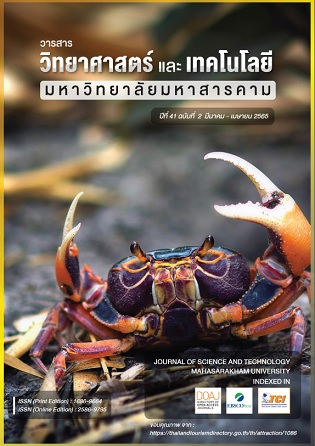STUDY OF GEL FORMULATION FROM BARK OF TINOSPORA CRISPA EXTRACT WITH INFLAMMATORY ACNE
Main Article Content
Abstract
This research is a qualitative research. The purpose of this research was studied to compare maceration and soxhlet extraction methods with 95% ethanol from bark of Tinospora crispa and development of gel formulation form bark of T. crispa with inflammatory acne. Then, absorbance to measure at wavelength 292 and 319 nanometer by UV-VIS spectrophotometer. After that, the development to gel formulation with physical property, chemical property and stability tests by freeze thaw cycles. The results showed that the T. crispa extract with maceration method have %yield as 18.81 more than 7.76 to compare with soxhlet extraction as 11.05, respectively. The suitable concentration for the stability test of the extract in the formulation was 0.30 mg/mL and the formulation of 1.0% Carbopol® 940 with crude extract of T. crispa was the highest stability.
Article Details
References
Abood, W. N., Fahmi, I., Abdulla, M. A. & Ismail, S. (2014). Immunomodulatory effect of an isolated fraction from Tinospora crispa on intracellular expression of INF-gamma, IL-6 and IL-8. BMC Complementary and Alternative Medicine, 1-12.
Agnihortri, S., Wakodev, S. & Agnihotri, A. (2010). An Overview on anti-inflammatory Properties and Chemo-Profiles of plants used in traditional medicine. Indian journal of Natural Products and Resources, 151-165.
Ahmad, W., Jantan, I. & Bukhari, S. N. A. (2016).Tinospora crispa (L.) Hook. f. & Thomson: A Review of Its Ethnobotanical, Phytochemical, and Pharmacological Aspects. Frontiers in Pharmacology, 1-19.
Ali, M. J., Obaid, R. F. & Obaid, R. F. (2019). Antibacterial activity for acne treatment through medicinal plants extracts: Novel alternative therapies for acne. Journal of Pure and Applied Microbiology. 13(2), 1245-1250.
Department of Medical Sciences, Ministry of Public Health, Thailand. (1998). Thai Herbal Pharmacopoeia volume I: Boraphet. Office of Notional Buddishm Press: Bangkok. (in Thai)
Do, J. E., Cho, S. M., In, S. I., Lim, K. Y., Lee, S., & Lee, E. S. (2009). Psychosocial aspects of acne vulgaris: A community-based study with Korean adolescents. Annals of Dermatology. 21(2), 125-129.
Farage M. A., Hood, W., Berardesca, E. & Maibach, H. (2018). Intrinsic and Extrinsic Factors Affecting Skin Surface pH. Current Problems in Dermatology. 54, 33-47.
Higashino, H., Suzuki, A., Tanaka, Y. & Pootakham, K. (1992). Inhibitory effects of siamese Tinospora crispa extracts on the carrageenin-induced foot pad edema in rats (the 1st report). Folia Pharmacologica Japonica. 100(4), 339-344.
Homhual, S. (2010). Tinospora crispa. Faculty of Pharmaceutical Sciences, Ubon Ratchathani University. Retrived October 18, 2018 from http://www.phargarden.com/main.php? action=viewpage&pid=64 (in Thai)
Ibahim, M., Izzah, W. N. W., Narimah, A., Asyikin, N. Z., Shafinas, S.-N. S., & Froemming, G. (2011). Anti-proliperative and antioxidant effects of Tinospora crispa (Batawali). Biomedical Research-India. 22, 57–62.
Ismail, M. & Choudhary, M. I. (2016). Compounds Isolated from Tinospora crispa. Chemistry of Natural Compounds. 52(6), 1151-1153.
Khunawattanakul, W., Caichompoo, W., Mekjaraskul, C., Charoenmit, A., Lekdee, C. & Srichan, N. (2017). Anti-Propionibacterium acnes from Thai herbal medicines. Journal of Science and Technology Mahasarakham University. 36(5), 608-613. (in Thai)
Koay, Y. C. & Amir, F. (2013). A Review of the Secondary Metabolites and Biological. Tropical Journal of Pharmaceutical Research, 641-649.
Kongsaktrakoon, B., Temsiririrkkul, R., Suvitayavat, W., Nakornchai, S. & Wongkrajang, Y. (1994). The antipyretic effect of Tinospora crispa Mier ex Hook.f. & Thoms. Mahidol University Journal of Pharmaceutical Sciences. 21(1), 1-6.
Lambers, H., Piessens, S., Bloem, A., Pronk, H., & Finkel, P. (2006). Natural skin surface pH is on average below 5, which is beneficial for its resident flora. International Journal of Cosmetic Science. 28(5), 359-370.
Mokkhasmit, M., Ngarmwathana, W., Sawasdimongkol, K. & Permphiphat, U. (1971). Pharmacological evaluation of Thai medicinal plants (continued). Journal of the Medical Association of Thailand. 54(7), 490-504.
Monika, M., Stefanie, H. & Alois, J. (2010). Anti-inflammatory activity of extracts from fruits, herbs
and spices. Elsevier Ltd, 989-996.
Noor, H. Hammonds, P., Sutton, R. & Asheroft S.T.H. (1989). The Hypoglycaemic and Insulinotropic activity of Tinospora crispa: Studies with human and rat islets and HIT-TISB cell. Diabetologia. 32(6), 354-359.
Rowe, R. C., Sheskey, P. J., Cook, W. G. & Fenton, M. E. (2012). Handbook of Pharmaronceutical
Excipients (Seventh Edition). USA: Pharmaceutical Press.
Schmid-Wendtner, M. H., & Korting, H. C. (2006). The pH of the skin surface and its impact on the
barrier function. Skin Pharmacology and Physiology. 19(6), 296-302.
Sharma, P., Dwivedee, B. P., Bisht, P., Dash, A. K. & Kumar, D. (2019). The chemical constituents and diverse pharmacological importance of Tinospora cordifolia. Heliyon. 5, 1-8.
Sihabud, V., Duangjit, S., Yingngam, B. & Pitchayajittipong, C. (2018). Development of Sesame Oil Loaded Bigels for Dry Skin Relief. Isan Journal of Pharmaceutical Sciences. 14(4), 122-131. (in Thai)
Smitinand, T. (2010). Thai plant names. Thai Jounal Online.Retrived January 20, 2018 from http://eherb.hrdi.or.th/ search_result_details.php?herbariumID=722 (in Thai)
Sriyapai, C., Dhumma-upakorn, R Sangwatanaroj, S., Kongkathip, N. & Krittiyanunt, S. (2009). Hypoglycemic effect of Tinospora crispa dry powder in outpatients with metabolic syndrome at king chulalongkorn memorial hospital. Journal of Health Research. 23(3), 125-133.
Techasatian, L. (2016). Acne. The heart of pediatrics, 32. Srinagarind Medical Journal, 31(5), (Supplement), Khon Kaen University. (in Thai)
Udompataikul, M. (2018). Dermatology: Acne Vulgaris. The Royal College Pediatricians of Thailand. Retrived June 15, 2020 from http://www.thaipediatrics.org/Media/media-20180403103621.pdf (in Thai)
U.S. Department of Health and Human Services Food and Drug Administration. (1998). Guidance for Industry Stability Testing of Drug Substances and Drug Products. Draft Guidance, 72.
Wetwitayaklung, P. (2012). Anti-inflammatory of Ginseng. Department of Pharmacognosy, Silpakorn University. (in Thai)
Yokozawa, T., Tanaka, T. & Kimura, T. (2001). Examination of the Nitric Oxide Production-Suppressing Component in Tinospora tuberculata. Biological and Pharmaceutical Bulletin. 24(10), 1153-1156.
Zulkefli, H. N., Mohama, J. & Abidin, N. Z. (2013). Antioxidant activity of methanol extract of Tinospora crispa and Tabernaemontana corymbosa. Sains Malays, 697–706.


